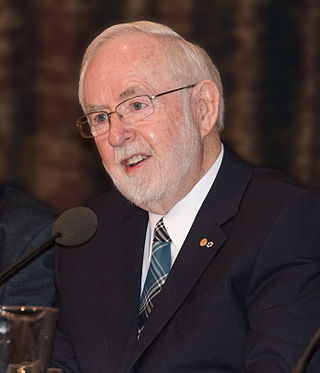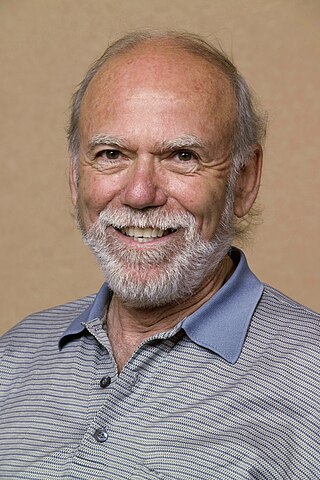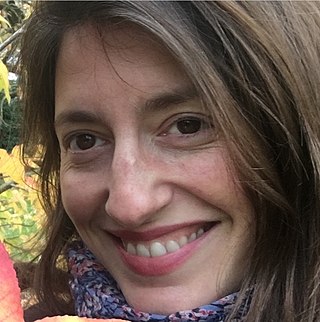Related Research Articles
The Cryogenic Dark Matter Search (CDMS) is a series of experiments designed to directly detect particle dark matter in the form of Weakly Interacting Massive Particles. Using an array of semiconductor detectors at millikelvin temperatures, CDMS has at times set the most sensitive limits on the interactions of WIMP dark matter with terrestrial materials. The first experiment, CDMS I, was run in a tunnel under the Stanford University campus. It was followed by CDMS II experiment in the Soudan Mine. The most recent experiment, SuperCDMS, was located deep underground in the Soudan Mine in northern Minnesota and collected data from 2011 through 2015. The series of experiments continues with SuperCDMS SNOLAB, an experiment located at the SNOLAB facility near Sudbury, Ontario in Canada that started construction in 2018 and is expected to start data taking in early 2020s.

SNOLAB is a Canadian underground science laboratory specializing in neutrino and dark matter physics. Located 2 km below the surface in Vale's Creighton nickel mine near Sudbury, Ontario, SNOLAB is an expansion of the existing facilities constructed for the original Sudbury Neutrino Observatory (SNO) solar neutrino experiment.

Arthur Bruce McDonald, P.Eng is a Canadian astrophysicist. McDonald is the director of the Sudbury Neutrino Observatory Collaboration and held the Gordon and Patricia Gray Chair in Particle Astrophysics at Queen's University in Kingston, Ontario from 2006 to 2013. He was awarded the 2015 Nobel Prize in Physics jointly with Japanese physicist Takaaki Kajita.

Katherine Freese is a theoretical astrophysicist. She is currently a professor of physics at the University of Texas at Austin, where she holds the Jeff and Gail Kodosky Endowed Chair in Physics. She is known for her work in theoretical cosmology at the interface of particle physics and astrophysics.

Barry Clark Barish is an American experimental physicist and Nobel Laureate. He is a Linde Professor of Physics, emeritus at California Institute of Technology and a leading expert on gravitational waves.

Mayly Sánchez is a Venezuelan-born particle physicist who researches at Iowa State University. In 2011, she was awarded the Presidential Early Career Awards for Scientists and Engineers (PECASE), the highest honor given by the United States to scientists who are in the early stages of their research careers, for her contributions to the study of neutrinos and her work in promoting STEM fields to women. In 2013, she was named by the BBC as one of the top ten women scientists in Latin America.

JoAnne L. Hewett is a theoretical particle physicist on the faculty of the SLAC National Accelerator Laboratory at Stanford University, where she is a professor in the Department of Particle Physics and Astrophysics. Since 2017 she has been the associate lab director of the Fundamental Physics Directorate and the chief research officer at SLAC. Her research interests include physics beyond the Standard Model, dark matter, and hidden dimensions. She is a fellow of the American Physical Society and a fellow of the American Association for the Advancement of Science (AAAS).
Bernard Sadoulet is a French physicist.
Laura Baudis (1969) is a Romanian-born Swiss particle astrophysicist. She is employed as a full professor by the University of Zurich, Switzerland. Her research focuses on dark matter and neutrino physics. She is a member of the science strategy team for XENON as well as the CERN Scientific Policy Committee (2016–18) and the PSI Research Committee for Particle Physics.
Kate Scholberg is a Canadian and American neutrino physicist whose research has included experimental studies of neutrino oscillation and the detection of supernovae. She is currently the Arts & Sciences Distinguished Professor of Physics and Bass Fellow at Duke University.

Jocelyn Monroe is an American British experimental particle physicist who is a professor at the University of Oxford. Her research considers the development of novel detectors as part of the search for dark matter. In 2016 she was honoured with the Breakthrough Prize in Fundamental Physics for her work on the Sudbury Neutrino Observatory.

Reina H. Maruyama is a Japanese–American experimental particle/atomic/nuclear physicist. As a professor at Yale University, Maruyama was elected a Fellow of the American Physical Society for her "innovative and wide-ranging contributions to the experimental study of rare events and fundamental symmetries, especially the search for neutrinoless double beta decay, and for leadership in understanding the signature and nature of dark matter."
Cecilia Lunardini is an Italian nuclear astrophysicist known for her research on neutrinos from the sun, from the cosmic neutrino background, from supernovae and failed supernovae, and from collisions of stars with black holes. She is a professor of physics at Arizona State University.
Amy Lynn Connolly is an American physicist. She is an associate professor in the Department of Physics at Ohio State University and a Fellow of the American Physical Society for "her contributions to experimental and theoretical studies of ultrahigh energy neutrinos, and to searches for these neutrinos using radio techniques."
Teresa Montaruli is an Italian astronomer specializing in neutrino astronomy, and in particular in the search for high-energy neutrinos from cosmic sources. She is a professor in the particle physics department at the University of Geneva.
Nicole F. Bell is an Australian physicist who is a professor at the University of Melbourne. She is a theoretical physicist who works on dark matter, neutrino physics, and other topics in particle and astroparticle theory.
Ina Šarčević is a Yugoslav-American theoretical astrophysicist who studies high-energy cosmic particles, especially neutrinos, and the implications of particle physics for dark matter and cosmology. She is a professor of physics and of astronomy at the University of Arizona.
Fiorenza Donato is an Italian theoretical astroparticle physicist whose research involves the study of cosmic rays and their use in understanding the nature of dark matter, the possible products of particle collisions involving dark matter, the creation and behavior of antimatter among high-energy cosmic particles, and gamma-ray astronomy. She is a full professor of theoretical physics at the University of Turin.
Daniel S. Akerib is an American particle physicist and astrophysicist. He was elected in 2008 a fellow of the American Physical Society (APS).
Lindley Winslow is an experimental nuclear and particle physicist, and associate professor at MIT.
References
- 1 2 Dr. Jodi Cooley named Executive Director of SNOLAB, SNOLAB, June 30, 2022, retrieved 2022-10-21
- 1 2 3 Curriculum vitae (PDF), Southern Methodist University, January 26, 2019, retrieved 2022-10-21
- ↑ "SMU Physicist Honored for Dark Matter Research: Jodi Cooley named fellow of American Association for the Advancement of Science", SMU Research News, Southern Methodist University, November 28, 2018, retrieved 2022-10-21
- ↑ "Fellows nominated in 2022 by the Division of Nuclear Physics", APS Fellows archive, American Physical Society, retrieved 2022-10-21
- ↑ Jodi A. Cooley Named as Recipient of the 2019 Klopsteg Memorial Lecture Award, American Association of Physics Teachers, March 28, 2019, retrieved 2022-10-21